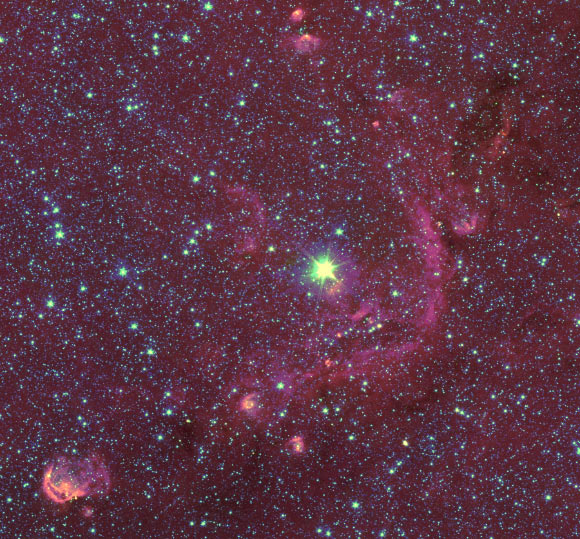Study Sheds New Light on Evolution of Yellow Hypergiants | Astronomy – Sci-News.com
In a study published this month in the journal Astronomy & Astrophysics, astronomers analyzed the properties of four yellow hypergiant stars, including their atmospheric pulsations and long-term variations.

This image from NASA’s Spitzer Space Telescope shows the yellow hypergiant HR 5271A. Image credit: A. Lobel / NASA / Spitzer Space Telescope / IRAC.
Yellow hypergiants are extremely luminous, massive stars with an extended atmosphere.
These stars are 15-20 times heavier than the Sun and about 500,000 times more luminous.
They are very rare, with just 15 known in our Milky Way Galaxy.
“The atmospheres of these stars can be so huge that, if they replaced our Sun, they would stretch beyond the orbit of Jupiter,” said Dr. Alex Lobel, an astronomer at the Royal Observatory of Belgium, and his colleagues from the Netherlands, Australia, New Zealand, and the Unted States.
The astronomers explored the properties of yellow hypergiants HR 8752, HR 5171A, ρ Cas, and HD 179821.
They analyzed the multi-color and visual photometric data sets spanning from 50 to 100 years of observations.
“Because we had such a long series of measurements, we could see in detail how the stars get warmer over decades and cool down in a few years,” they noted.
Dr. Lobel and co-authors found that the temperature of the yellow hypergiants can increase from 4,000 K to 8,000 K and back again in a few decades.
“The cycle begins with a cool star. In a few decades, the average atmospheric temperature increases to about 8,000 K,” they explained.
“At 8,000 K, however, the atmosphere becomes unstable due to amplified pulsations.”
“At a certain moment the entire atmosphere erupts. As a result, it cools down quickly and a self-accelerating process occurs in which electrons attach themselves to hydrogen ions and a lot of ionization energy is released. This cools the atmosphere even further.”
“The cooling from 8,000 K to 4,000 K takes only two years.”
“Then the cycle starts again from the beginning, only with a slightly less massive star.”
“Eventually, the hypergiant transforms into a hotter star and ends its life as a supernova.”
“We also found out that one of the four studied hypergiants, HR5171A, was not as large as previously assumed,” they said.
“HR5171A and ρ Cas turn out to be much closer to our Solar System than expected.”
_____
A. van Genderen et al. 2019. Pulsations, eruptions and evolution of four yellow hypergiants. A&A, in press; doi: 10.1051/0004-6361/201834358






